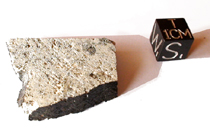Eucrites
The Eucrites are named for a Greek word meaning "easily
distinguished". Representing the most common class of achondrites,
more than 100 eucrites are known, excluding all probable pairings.
Although they are easily distinguished from chondrites, they closely
resemble terrestrial basalts. Actually, eucrites are extraterrestrial
basalts, volcanic rocks of magmatic origin, representing the crust of
their parent body, Vesta. They are primarily composed of the calcium-poor
pyroxene, pigeonite, and the calcium-rich plagioclase, anorthite.
Additionally, eucrites often contain accessory minerals such as silica,
chromite, troilite, and nickel-iron metal. Based on mineralogical and
chemical differences, the eucrites have been further divided into three
distinct subgroups: the non-cumulate group, the cumulate
group, and the polymict group.
|
Talampaya
1995, Argentina
1.421 kg
Cumulate eucrite
Witnessed fall!
|
|
|
 
|
|
|
|
Talampaya 00
9.30 gr
Superb fresh slice with incredible fusion crust !
Price on request
|
|
|
|
|
|
|
|
Talampaya 01
5.50 gr
An other smaller perfect slice with fusion crust !
SOLD
|
|
|
|
  |
|
|
|
|
|
|
|